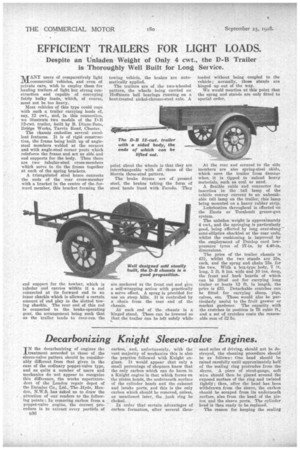EFFICIENT TRAILERS FOR LIGHT LOADS.
Page 20

If you've noticed an error in this article please click here to report it so we can fix it.
Despite an Unladen Weight of Only 4 cwt., the D-B Trailer is Thoroughly Well Built for Long Set vice.
iur ANY users of comparatively light .111..commercial vehicles, and even of private cars, wish to employ these for hauling trailers of light but strong construction and capable of conveying fairly bulky loads, which, of course, must not be too heavy.
Most vehicles of this type could cope with such a trailer carrying loads of, say, 12 cwt., and, in this connection, we illustrate two models of the D-B 12-cwt, trailer, built by B. Dixon-Bate, Bridge Works, Tarvin Road, Chester.
The chassis embodies several excellent features. It is of rigid construction, the frame being built up of anglesteel members welded at the corners and with angle-steel corner posts which reinforce the frame and act as side and end supports for the body. Then there are two tubular-steel cross-members which serve to tie the frame together at each of the spring brackets.
A. triangulated steel brace .connects the ends of the rear cross-member with a bracket in the centre of the,forward member, this bracket forming the end support for the towbar, which is tubular and carries within it a rod connected at its forward end to an inner shackle which is allowed a certain amount of end play in the slotted towing shackle. The rear end of this rod is connected to the brake-operating gear, the arrangement being such that as the trailer tends to over-run the towing vehicle, the brakes are automatically applied.
The trailers are of the two-wheeled pattern, the wheels being carried on Hoffmann ball bearings running on a heat-treated nickel-chrome-steel axle. A point about the wheels is that they are interchangeable with all those of the Morris three-stud pattern.
The brake drums are of pressed steel, the brakes taking the form of steel. hands lined with Perodo. They are anchored at the front end and give a self-wrapping action with practically a servo effect. A sprag is provided for use on steep hills. It is controlled by a chain from the rear end of the chassis.
At each end of the chassis is a hinged stand. These can be lowered so that the trailer can be left safely while loaded without being coupled to the vehicle; normally, these stands are hinged up out of the way.
We would mention at this point that the sprag and stands are only fitted to special order.
At the rear and secured to the side members are also spring-steel skids, which save the trailer from damage when it is tipped to unload heavy materials, such as coal or sand.
A flexible cable and connector for insertion in the tail lamp of the vehicle convey current to an unbreakable tail lamp on the trailer, this lamp being mounted on a heavy rubber strip.
Lubrication throughout is effected On the Enots or Teealemit grease-gun system.
The unladen weight is approximately 4 cwt., and the springing is particularly good, being effected by long over-slung semi-elliptics shackled at the rear ends, whilst the cushioning is improved by the employment of Dunlop cord lowpressure tyres of 27-in. by 4.40-in. dimensions.
The price of the trailer chassis is *31, whilst the two stands are 15s. each, and the sprag and chain 15s. for the two. With a box-type body, 7 ft. long, 3 ft. 8 ins. wide and 10 iris, deep, the front and back boards ef which can he lifted out for carrying lung timber or boats 12 ft. in length, the price is fal. Detachable crutches can be fitted for carrying sheep, pigs, calves, etc. These would also be particularly useful to the fruit grower or market gardener. The capacity with the clutches in position is 75 cubic ft., and a set of cratches costs the reasonable sum of £2 5s.
































